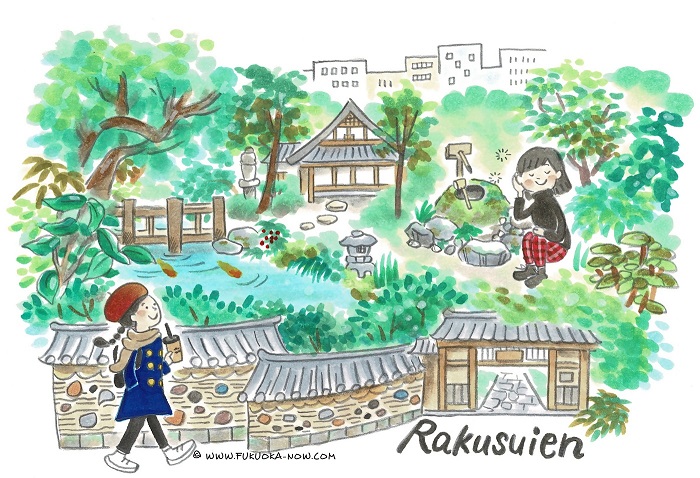Hakata Culture vol.192
Rakusuien: A Tranquil Japanese Garden in the Heart of the City

About a 10-minute walk from Hakata Station you will find Rakusuien, a Japanese garden with a serene atmosphere. This is originally where the Hakata merchant Shimozawa Zenemon Chikamasa built his second home, Sumiyoshi Villa, in 1906. Chikamasa, along with his father Naomasa, contributed to the development of Hakata for two generations with their family business. Rakusui was Chikamasa's pen name. Chikamasa established a teahouse called Rakusuian on this site, and it was here that he enjoyed performing tea ceremony.
After the war, the villa became an inn called Raksusuiso, and Rakusuien carries on this name to this day. In 1995, Fukuoka City developed the site into a Japanese garden built around a pond and opened it to the public. Carefully placed trees and lanterns surround the pond, and visitors can enjoy seasonal scenery like cherry blossoms in the spring and the changing leaves in the fall. There is also a waterfall made from natural stone, and the garden is so quiet that you will forget that you are in the middle of the city as you stroll through the grounds.
Before you enter Rakusuien, you will notice the Hakata-bei clay walls. In the 16th century, after Hakata was destroyed by battles between warring clans, Toyotomi Hideyoshi ordered the redistricting of the town. Charred fragments of stones and tiles from buildings that had been leveled during the war were repurposed in the earthen walls of shrines, temples and the mansions of wealthy merchants. These unique walls are called Hakata-bei. The Rakusuian tea room in the garden is a restored version of the teahouse originally built by Chikamasa. When not in use for tea ceremonies, visitors can pay a fee and enjoy matcha and seasonal sweets. There is something special about enjoying a cup of green tea served in an authentic tea room.
There is also a suikinkutsu in one corner of the garden. This is a type of musical garden ornament that is made by burying an upside-down jar in the ground under a tsukubai, a stone wash basin where you purify your hands before entering a teahouse. The drops of water from the basin strike the jar to create pleasant tones that reverberate faintly from underground. Rakusuien is also used for official tea ceremonies, nodate (outdoor tea ceremonies) and wedding photo shoots. It serves as an urban oasis together with the nearby Sumiyoshi Shrine.
都会の中の静かな日本庭園・楽水園
博多駅から歩いて10分ほどの楽水園は、落ち着いた雰囲気を漂わせる日本庭園。博多商人・下澤善右衛門親正(しもざわぜんえもんちかまさ)が、1906年に住吉別荘を建てた場所の跡地です。親正は、父の尚正(なおまさ)と親子二代にわたり、家業と並んで福博の発展に貢献した人物で、「楽水」は親正の雅号でもありました。この地に茶室「楽水庵」を設けて茶の湯を楽しんでいました。
戦後、この場所は旅館となって「楽水荘」と名付けられ、楽水園は当時の名を受け継いたものです。1995年には福岡市が池泉回遊式の日本庭園として整備して公開。園内は池を囲むように樹木や灯籠が配置され、春の桜や秋の紅葉など、四季折々の景色が楽しめます。自然石を利用した滝もあり、のんびり散策していると都会の真ん中にいることを忘れてしまいそうな静かさです。
楽水園の入り口にあるのは博多塀。豊臣秀吉が博多の町の戦後復興、いわゆる太閤町割りを行ったとき、神社・仏閣や豪商の屋敷の土塀に戦火で焼けた石や瓦を使ったのが始まりとされます。また園内の茶室「楽水庵」は、親正が建てた茶室を復元したもの。お茶会などで利用されていないときは、誰でも有料で抹茶と季節のお菓子がいただけます。本格的な茶室でいただくお茶は格別です。
庭園の一角には水琴窟があります。水琴窟とは、茶室に入る前に手を清めるために置かれた「つくばい」の下に、地中に瓶などを埋めて空洞を作り、その中に水滴を落として反響音を楽しむものです。耳をすますと地中から、かすかな音色が響いてきます。本格的な茶会や野点、結婚式の前撮りなどにも使われる楽水園。近隣にある住吉神社とあわせて都会のオアシスとなっています。

